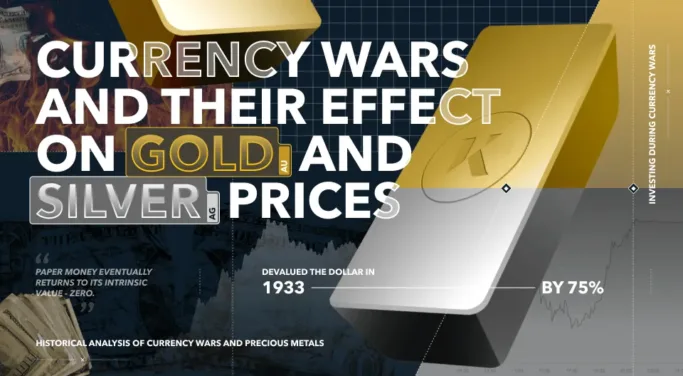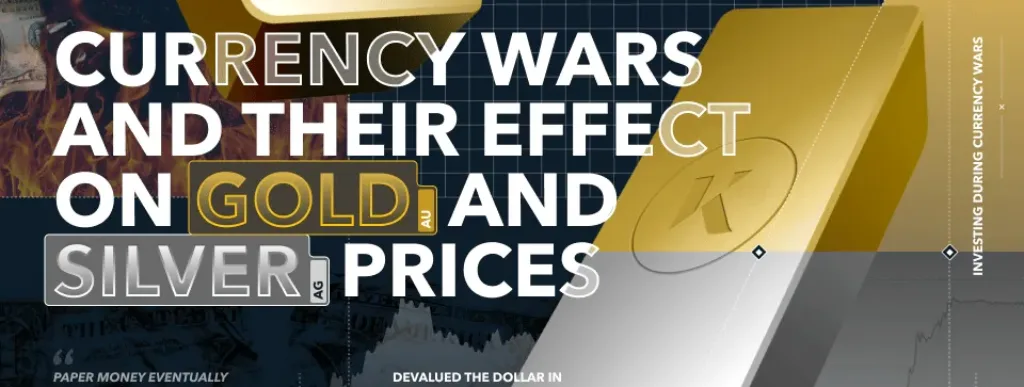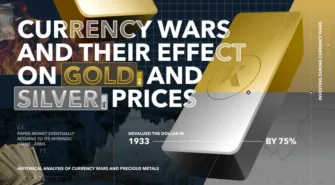Voltaire famously said: “Paper money eventually returns to its intrinsic value – zero.”
Governments use competitive fiat currency devaluations – or currency wars – to stimulate their respective economies. This, in turn, can have a positive impact on the price of gold and silver.
In global finance, the phenomenon of currency wars is not just a theoretical concept but a recurring historical event with significant implications for the gold and silver markets. As we examine the current economic landscape, it’s evident that the echoes of past currency wars still resonate in today’s markets.
Are we in the midst of a currency war? The signs point affirmatively, and the lessons from history underscore the profound impact such wars have on precious metals.
Introduction to Currency Wars
Currency wars, characterised by competitive devaluations, are not a novel strategy. They have been a tool used by nations throughout history to gain a trade advantage.
This economic tactic often emerges in times of widespread financial distress, when several countries implement policy decisions to devalue their fiat currencies and boost their economies by making their exports cheaper. In addition, devaluing a currency increases the expense of imported goods. In a sense, currency wars are a form of trade wars.
Historical Analysis of Currency Wars and Precious Metals
One major historical example of a currency war was during the 1930s, triggered by the Great Depression. Countries abandoned the Gold Standard, leading to a devaluation race to revive their struggling economies.
The United States, under President Franklin D. Roosevelt, devalued the dollar in 1933 by 75% against the price of gold, leading to a significant rise in gold prices. This era vividly illustrates how currency devaluation can enhance the appeal of gold as a store of value.
Another example is the competitive devaluations that occurred in the late 1960s and early 1970s, leading up to the collapse of the Bretton Woods system. As countries like the United States and the United Kingdom devalued their currencies, there was a marked shift towards gold as a hedge against currency instability, culminating in the end of the dollar’s convertibility into gold in 1971.
More recently, the 2010s saw what some economists term as a ‘modern currency war,’ initiated after the 2008 financial crisis. To stimulate the economies, many countries including the US, Europe, and Japan engaged in aggressive monetary easing which in turn devalued their currencies. This currency devaluation was reflected in price inflation and higher precious metals prices. As such, this period witnessed a new record high in gold, and a near-record price for silver, thereby reaffirming their status as safe-haven assets.
In the current scenario, the aggressive monetary policies by central banks worldwide, coupled with geopolitical tensions and trade disputes, bear the hallmarks of a currency war. This economic milieu has direct implications for gold and silver. As history has shown, in times of currency devaluation, these precious metals regain their allure. Gold, in particular, has been a beneficiary of currency wars, as investors flock to it as a hedge against currency devaluation and inflation.
Silver, while often overshadowed by gold, also gains from its dual role as an industrial metal and a precious metal. Silver was the world’s first reserve currency. The rising industrial demand, coupled with its value as a monetary asset, positions silver favourably in times of currency turmoil.
Investing During Currency Wars
While aggressive monetary ease and geopolitical uncertainties continue, these mirror the conditions that have historically led to currency wars. The resultant devaluation of fiat currencies enhances the appeal of gold and silver as stores of value.
These metals, with their limited supply and universal acceptance, provide fortification against the eroding purchasing power of inflating paper currencies. And I’m not the only analyst who holds this view.
Underpinned by historical insights, it is crucial for investors navigating the precious metals market to understand the dynamics of currency wars. The current trends, echoing past events, suggest a bullish outlook for gold and silver, reaffirming the metals’ roles as the ultimate forms of money in a world grappling with depreciating currencies. In these uncertain times, the wisdom of turning to these time-tested stores of value becomes increasingly clear.
The ongoing currency war is a pivotal factor shaping the gold and silver markets. Drawing lessons from historical precedents, it’s evident that such economic scenarios bolster the case for precious metals as haven assets during periods of fiat currency devaluations. As nations engage in competitive devaluation, the intrinsic value of fiat currencies is scrutinised, enhancing the appeal of gold and silver.
Dave Kranzler is a hedge fund manager, precious metals analyst and author. After years of trading expertise build-up on Wall Street, Dave now co-manages a Denver-based, precious metals and mining stock investment fund.
This publication is for informational purposes only and is not intended to be a solicitation, offering or recommendation of any security, commodity, derivative, investment management service or advisory service and is not commodity trading advice. This publication does not intend to provide investment, tax or legal advice on either a general or specific basis. The opinions expressed in this article, do not purport to reflect the official policy or position of Kinesis.
Read our Editorial Guidelines here.




